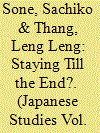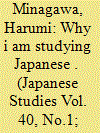|
|
|
Sort Order |
|
|
|
Items / Page
|
|
|
|
|
|
|
| Srl | Item |
| 1 |
ID:
171949


|
|
|
|
|
| Summary/Abstract |
Loanwords (gairaigo), words ‘borrowed’ from other languages, are an integral part of the Japanese language, and are estimated to account for around 10% of the modern Japanese lexicon. While loanwords are conventionally written with the katakana script, some contemporary examples appear in the hiragana script, which is usually reserved for words of Japanese origin. A corpus of loanwords in hiragana was assembled and analysed in order to describe typical characteristics of these words, such as the source language and method of elongating vowels, as well as the genres of text in which such words appear. The motivation for the use of hiragana for loanwords is also discussed, and expands on selected well-documented functions of loanwords. For example, loanwords can be used to fill lexical gaps, or give a ‘cool’ or ‘modern’ image to a referent. These functions are discussed specifically in relation to loanwords in hiragana. The results of this study extend prior research on loanwords in Japanese, and reinforce the often-cited flexibility and adaptability of the Japanese writing system.
|
|
|
|
|
|
|
|
|
|
|
|
|
|
|
|
| 2 |
ID:
171951


|
|
|
|
|
| Summary/Abstract |
This paper explores social identity through the rituals and exchange networks of alcohol among new Japanese immigrants (shin-issei) in a Japanese-style pub (izakaya) in Honolulu. Currently, over 18,000 shin-issei live on Oahu. Compared to the larger population of Japanese-Americans (approximately 300,000), these Japanese transnationals constitute a small, overlooked diaspora limited by cultural and economic barriers. The izakaya provides a place where identity is mediated through mutual alcohol consumption in close social groups, most notably through interaction via gift exchanges and commodity purchases. The form of alcohol rituals is distinct as it is a reconfiguration of embodied practices long cultivated in Japan, traceable to indigenous religious use and modernization near the end of the nineteenth century. In contemporary Honolulu alcohol becomes an object of relational transnational identities situated in an increasingly commodified sociocultural space.
|
|
|
|
|
|
|
|
|
|
|
|
|
|
|
|
| 3 |
ID:
171950


|
|
|
|
|
| Summary/Abstract |
International Retirement Migration (IRM) began in Europe and North America in the 1960s and the concept first entered Japan in the 1980s. Since the 1990s, it has become increasingly referred to as long stays/lifestyle migration. As sojourners seeking a better life overseas, Japanese later-life migrants tend to be perceived as temporary stayers and there has been little question about their sense of belonging. This study, based on a decade of observation and follow up interviews with a small sample of Japanese retiree migrants in Western Australia, examines how migrants’ decisions to stay or leave the host country are affected by the presence of their children, juxtaposed with their sense of belonging, particularly to their homeland. We identify four types of later-life migrants based on their eventual decision to leave or to stay: ‘the returnee’, the ‘on-going migrant’, ‘the potential settler’ and ‘the new citizen’. We argue that for later-life migrants who are constantly debating whether or not to remain in the host country until the end of their lives, the process of decision making is dynamic and often negotiated through a sustained sense of belonging to their homeland.
|
|
|
|
|
|
|
|
|
|
|
|
|
|
|
|
| 4 |
ID:
171948


|
|
|
|
|
| Summary/Abstract |
Between 1993 and 2018, Japan successfully applied to have 18 cultural sites and four natural sites inscribed on the UNESCO World Heritage List of places deemed to be of ‘outstanding universal value’ and ‘interest’. At first glance, the former appear as a disparate collection of monuments chosen strictly on the basis of their individual merits, but a closer examination reveals a number are bound together by a common discourse – ‘the Japan as cultural synthesizer thesis’ – which dates back to the Meiji period. In 1916 Ukita Kazutami lamented that while Japan’s unique ability to synthesize Asian and Western civilizations had positioned it to usher in a new, more advanced global civilization, Japan has never produced any unique cultural achievements worthy of the world’s respect. On what basis, then, could Japan gain international respect and justify its claim to world leadership? The World Heritage List has belatedly provided Japan with a venue to answer that question. UNESCO’s experts have bestowed international recognition upon cultural sites chosen and narrated by Japan to celebrate a proud national heritage that also possesses universal value characterized by respect for foreign cultures, religious tolerance, respect for nature, industrial communitarianism, and a commitment to world peace.
|
|
|
|
|
|
|
|
|
|
|
|
|
|
|
|
| 5 |
ID:
171952


|
|
|
|
|
| Summary/Abstract |
This article discusses findings from a nationwide survey of New Zealand tertiary-level students’ reasons for studying Japanese, their sense of satisfaction with the tertiary Japanese learning experience, and their future aspirations. The findings show that there are several aspects of students’ learning experiences which reflect a positive integrative orientation, while practical goals associated with the university learning context were also evident. The findings also suggest that the language learning context is multi-dimensional, supported by a number of different sources, both virtual and physical, as well as inside and outside the classroom. Furthermore, students from different programs within each university, and those who had or had not studied Japanese prior to entering university, revealed different attitudes towards learning Japanese and different visions of their future. While the study found that the majority of students are satisfied with their current university courses and value formal learning over informal acquisition of language, our findings suggest that teachers should reconceptualise their teaching roles to embrace the wider language learning context available to our students.
|
|
|
|
|
|
|
|
|
|
|
|
|
|
|
|
|
|
|
|
|